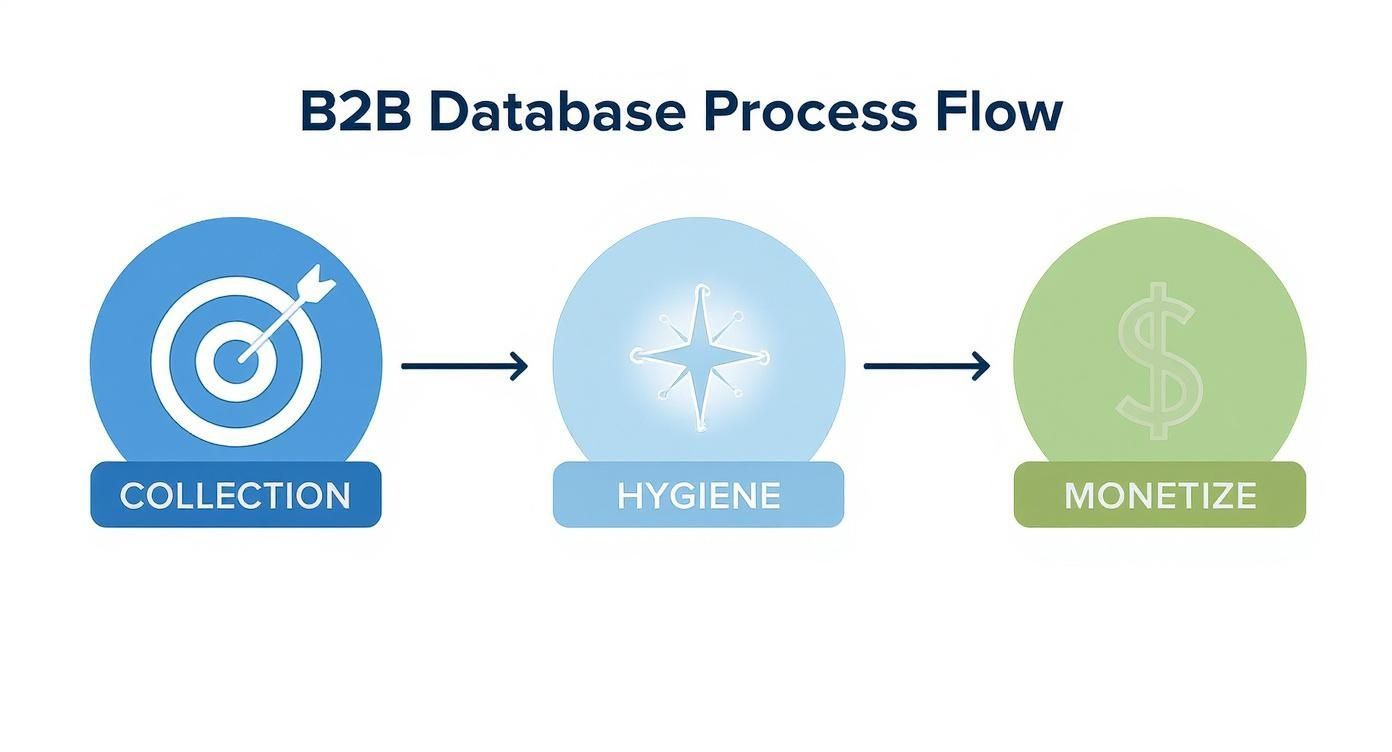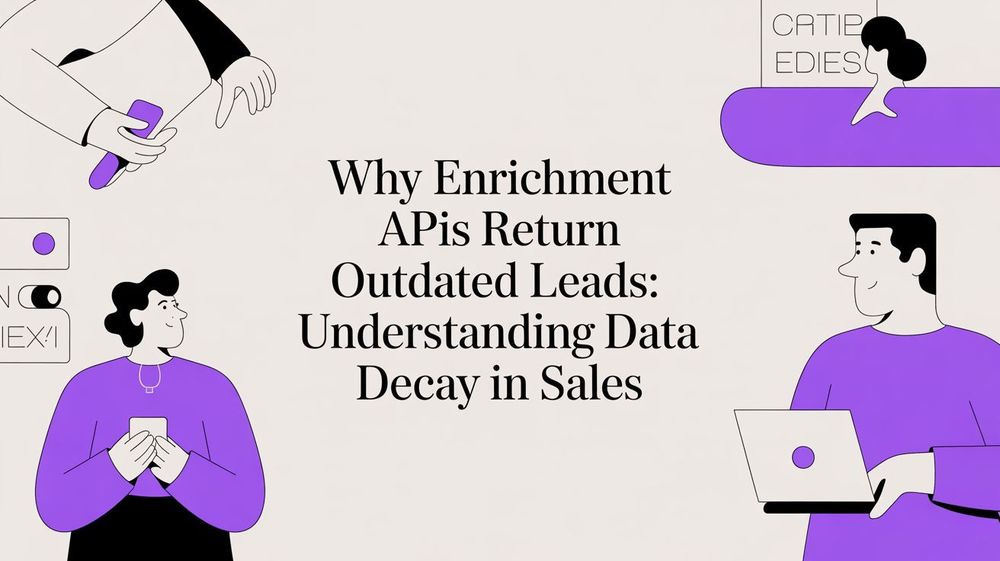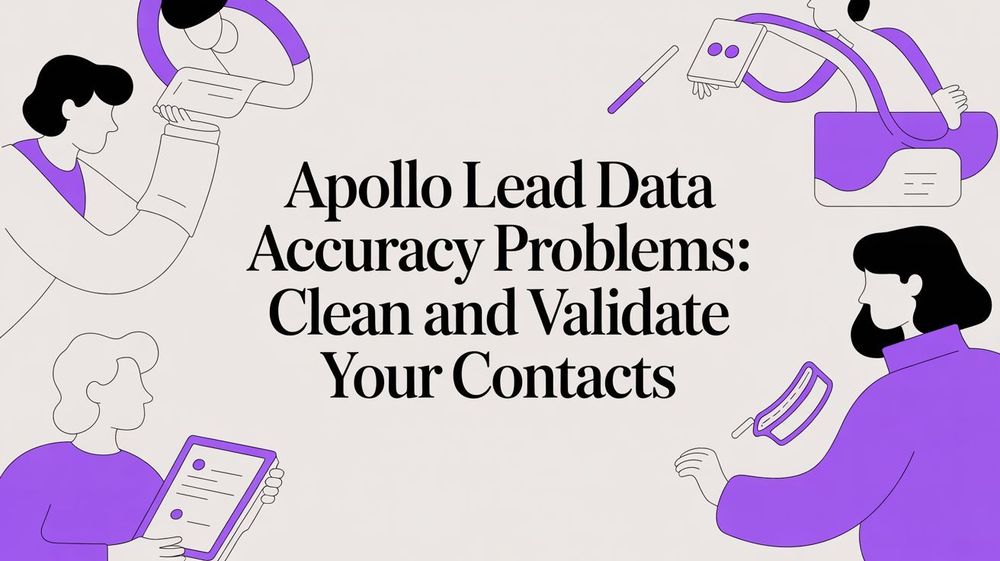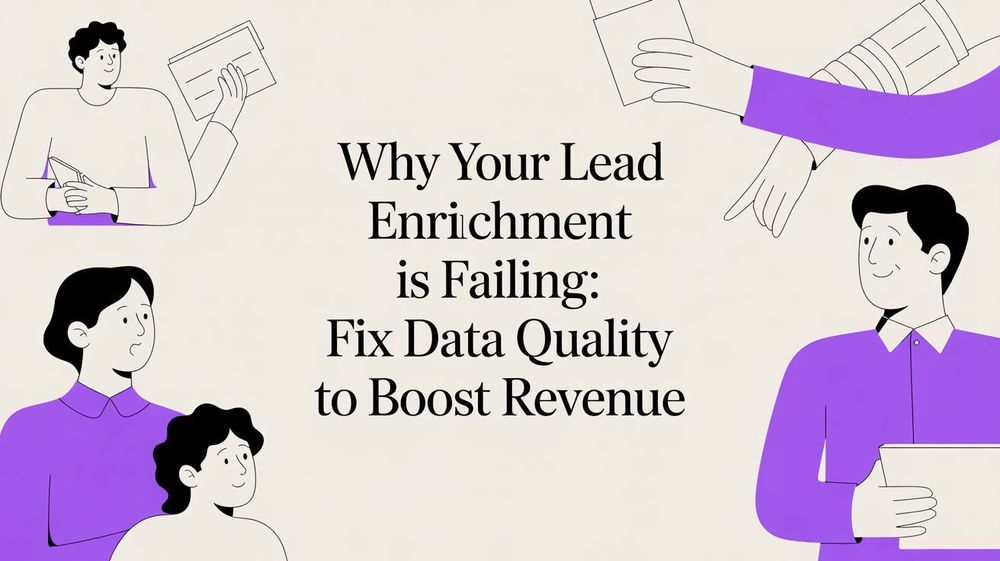Forget hoarding contacts. Building a B2B lead database is about creating a strategic, revenue-generating asset. But how do you actually turn a list of names into cash?
It really boils down to three core things: targeted data collection, meticulous data hygiene, and smart monetization models.
The fastest path I've seen work is this: build a laser-focused list of your ideal customer profiles (ICPs) using a no-code tool like ProfileSpider for one-click extraction. Then, keep that list squeaky clean through regular enrichment. From there, you can either sell it as a curated list or use it to power a value-added service.
Your Blueprint for a Profitable B2B Database
There's an old myth that a bigger database is always better. It's wrong. This thinking has led countless sales and marketing teams down a path of frustration and wasted money.
A massive, messy list of contacts is a liability, not an asset. It's a breeding ground for high email bounce rates, irrelevant prospects, and squandered resources. The modern, and frankly, more profitable approach is all about quality over quantity.
A truly valuable B2B database is a living thing. It starts with a crystal-clear understanding of who your ideal customer is and where they hang out online. Get that right, and you've laid the foundation for everything that comes next.
This whole process can be broken down into three main stages, from finding the data to actually making money from it.

As you can see, it’s a straightforward flow, but each step is critical. You can't jump to monetization without nailing collection and hygiene first. It just doesn't work.
To really grasp the shift in how this is done, it helps to see the old way versus the new way.
Core Pillars of a High-Value B2B Database
| Pillar | Traditional Method (The Hard Way) | Modern Method (The ProfileSpider Way) |
|---|---|---|
| Data Collection | Hours of manual copy-pasting from LinkedIn into spreadsheets. Slow and full of errors. | One-click AI extraction of hundreds of structured profiles from any website. Fast and accurate. |
| Data Hygiene | Purchasing static, outdated lists. Over 22% of B2B data decays annually. | Regular, one-click enrichment to keep profiles current and verified. Always fresh data. |
| Monetization | Selling generic, low-value lists or struggling with poor outreach results. | Selling niche, high-quality data or powering subscription services with reliable leads. |
This table sums it up pretty well: the modern approach saves an incredible amount of time and delivers a much higher-quality asset in the end.
From Manual Labor To Smart Automation
Traditionally, building a B2B lead list was a painful, manual grind. Picture a sales rep spending their entire day copying and pasting names, job titles, and company details from LinkedIn search results into a spreadsheet. It’s not just slow and mind-numbing; it's completely unscalable and riddled with human error.
The other "solution" was buying expensive, static lists that were already stale the moment you got them. B2B data decays at a staggering rate of over 22% per year. That means a huge chunk of a purchased list could be useless within just a few months.
The modern workflow throws these old methods out the window. Instead, it relies on AI-powered, no-code scraping tools to automate the most time-consuming parts of the job. With a tool like ProfileSpider, that same sales rep can pull hundreds of complete, structured profiles from a search results page in a single click, saving hours of manual data entry.
The Growing Urgency For Quality Leads
The demand for high-quality B2B leads has never been hotter. For 2025, lead generation is the top priority for most B2B companies, with 51% calling it an immediate focus.
This isn't just talk; it's reshaping budgets. A whopping 69% of firms are planning to increase their lead generation investments.
To really get this right, you need a solid foundation. This guide on how to build an email list effectively is a great starting point. It will walk you through the entire journey—from planning and collection to monetization—and show you how to ditch the slow, old-school methods for the efficient, one-click workflows anyone can use today.
Mastering B2B Data Collection and Enrichment
Let's be honest, B2B data collection used to be a soul-crushing grind. For years, it meant painstakingly scraping websites by hand, buying stale lists from sketchy vendors, or the ultimate time-suck: manually copy-pasting details from one social profile after another. These old-school methods are not just slow, they're wildly inaccurate.
Good news is, we're not stuck in the past. The modern approach is all about precision and automation. We're turning what was once a tedious chore into a smart, streamlined workflow that anyone can master.
From Manual Grind to One-Click Extraction
Picture this common scenario: you're a recruiter who needs to find 50 software engineers in Austin for a critical role. The old way? You’d spend hours digging through LinkedIn search results, manually copying names, companies, and profile URLs into a spreadsheet. That's a full day's work, easily, and it's guaranteed to have errors.
Now, let's look at the alternative. With a tool like ProfileSpider, you run the same LinkedIn search, pop open the extension, and hit "Extract Profiles." In seconds, its AI-powered engine grabs every single profile on the page—names, job titles, companies, locations, the works—and neatly organizes it into a clean, structured list, ready for export to CSV or Excel.
You can see just how clean the interface is after grabbing profiles from a webpage.

What took an entire afternoon is now done in about a minute. This is the new reality of data collection. It’s about using smart, no-code tools to build your B2B lead database with incredible speed, turning any website with professional profiles into a goldmine of actionable leads.
Finding and Enriching Your Initial Prospects
The first step in building a powerful database is figuring out where your ideal customers or candidates hang out online. It could be a professional network, an industry forum, or even a niche directory.
Your initial scrape should focus on grabbing that foundational profile info. Here are some of the best places to start:
- Professional Networks: LinkedIn and GitHub are absolute treasure troves for B2B data.
- Company 'About Us' Pages: Go straight to the source and pull decision-makers from your target companies.
- Event Speaker Lists: Conference websites are perfect for collecting profiles of industry experts and influencers.
- Business Directories: Niche online directories can help you zero in on companies in a specific location or vertical.
Once you have that raw list, the real magic happens: enrichment. An extracted profile might give you a name, title, and company, but it's often missing the crucial contact details. This is where most people get stuck and fall back into the manual-search trap.
Key Takeaway: Data enrichment is simply the process of adding missing information to your existing records. It’s what transforms a basic profile into a fully actionable lead by filling in the gaps—like emails and phone numbers.
With ProfileSpider, this is just another click. Select the profiles you want to flesh out and hit the “Enrich” button. The tool then gets to work, visiting the saved profile URLs and pulling in the missing contact info, adding verified emails and phone numbers right into your list. For a deeper dive into this, the Waterfall Enrichment method is a fantastic resource for advanced techniques.
This single feature is what elevates your database from a simple contact list to a true outreach machine. Your sales and recruiting teams get everything they need to connect with prospects, all within one seamless workflow. Doing this in bulk saves an insane amount of time and dramatically boosts the quality and value of your data. To see more on how no-code tools are completely changing this game, check out our guide on using an instant data scraper.
Keeping Your Data Clean and Segmented
Collecting B2B data is really just the first step. If you don't have a system to keep it clean and organized, that promising database you're building will quickly become a liability. An unaudited list of contacts is a minefield of outdated job titles, dead-end emails, and duplicate entries that will absolutely tank your campaign ROI before you even hit "send."
B2B data decays at a shocking rate, which means data hygiene isn't a one-and-done chore—it's something you have to bake into your process. You need a practical, ongoing workflow for maintaining data quality so your outreach efforts always hit their mark.
Taming the Data Chaos
First things first: you have to tackle the duplicates. When the same person shows up multiple times, it clutters your lists, completely skews your analytics, and can lead to some seriously embarrassing outreach mistakes, like when a prospect gets the same message from three different reps.
The old-school way involved agonizing over spreadsheets, wrestling with complex formulas just to find and merge rows. Not only is that process painfully slow, but it's also a breeding ground for human error and often results in lost data.
A modern approach automates this mess. For example, a tool like ProfileSpider lets you select a handful of profiles and hit a single “Merge Duplicates” button. It intelligently combines the information from all the different entries into one complete profile, making sure to keep all the unique data points without you having to lift a finger.
The Power of Smart Segmentation
Once your data is clean, it's time to get it organized. This is where smart segmentation transforms a simple contact list into a precision tool for personalized outreach and, ultimately, monetization. Instead of wrestling with one massive, unmanageable list, you create smaller, dynamic lists based on criteria that actually matter.
Think about these real-world scenarios:
- For a sales campaign: You could build a list called 'Tech CEOs in California' to target the right decision-makers for your new SaaS product.
- For a recruiting project: A list of 'Java Developers with 5+ Years Experience' would let you zero in on qualified candidates for a senior role.
- For a marketing initiative: You could compile 'Marketing VPs at B2B Fintechs' for a highly targeted account-based marketing campaign.
Achieving this level of organization is surprisingly easy with the right setup. ProfileSpider’s Smart Organization & Management features let you create as many custom lists as you need. You can add notes, apply statuses like 'Hot Lead,' and use custom tags like 'Follow-Up Q3' directly on each profile. This basically turns your database into a lightweight, actionable CRM that lives right in your browser. Our guide to the best contact management software dives into even more advanced strategies for organizing your leads.
Maintaining Database Health and Accuracy
Building and monetizing a B2B lead database is a strategic game, and it all comes down to data quality. While it's tempting to focus on the sheer quantity of leads, the data shows that accuracy is far more critical. Most providers only deliver contacts with about 50% accuracy, meaning half the records in a typical database could be outdated or just plain wrong.
This highlights a critical truth you must embrace: continuous verification and real-time data enrichment are non-negotiable. Relying on one-time data purchases or annual clean-ups is a recipe for failure.
A proactive data hygiene strategy boils down to a few key habits:
- Regular Enrichment: Every so often, run your most important segments through an enrichment process. If a contact has switched jobs, a good enrichment tool can often track down their new role and contact details automatically.
- Bounce Management: When you send an email campaign, pay close attention to the hard bounces. A hard bounce means the email address is invalid and should be flagged or removed from your active lists immediately.
- Scheduled Audits: Set a quarterly reminder to review your key lists. Look for outdated tags, incomplete profiles, and contacts who are no longer a good fit for your goals.
By embedding these practices into your workflow, you'll ensure your B2B database remains a high-value, revenue-generating asset instead of decaying into a forgotten list of dead-end contacts.
Navigating Data Privacy and Legal Compliance
Let's talk about the legal stuff. Building and selling access to a B2B lead database is a powerful business model, but ignoring data privacy isn't just risky—it's a surefire way to kill your business before it even gets off the ground.
The regulatory world can feel like a minefield, but you don't need a law degree to get it right. It's about being responsible and building a sustainable, trustworthy asset. This isn't about scare tactics; it's about making smart decisions from day one to protect yourself from massive fines and build a reputation people respect.
Understanding the Key Regulations
You've probably heard of the General Data Protection Regulation (GDPR) in Europe and the California Consumer Privacy Act (CCPA). These laws have set the global tone for data privacy, and their core principles are pretty similar: give people control over their personal data.
For B2B data, the concept of "legitimate interest" is your best friend. In most cases, this allows you to process publicly available professional data for business-to-business purposes, as long as it doesn't trample on an individual's rights. But this is not a free pass to do whatever you want.
It boils down to a few common-sense rules you must always be ready to follow:
- Be upfront about where you got someone's data if they ask.
- Make it painfully easy for anyone to opt out of your communications.
- If someone asks you to delete their data, do it. Immediately. No questions asked.
Operating ethically isn't just a legal checkbox; it's how you build a business that lasts.
Public vs. Private Data
There's a massive difference between public and private data, and it's a line you never want to cross.
Information people have willingly made public—on their LinkedIn profiles, company websites, or in professional directories—is generally fair game for B2B outreach. The key here is that they put that information out there themselves in a professional context.
This is why how you collect data is so important. Using tools to scrape publicly accessible webpages is a world apart from tapping into private databases or using shady tactics to get information.
Privacy-First Data Collection: Your best defense is to use tools that put you in complete control. ProfileSpider, for example, was built with this in mind. When you extract data, it's all stored locally in your browser's IndexedDB. No data is ever sent to external servers without your consent. This gives you total ownership and makes it easier to follow privacy-by-design principles from the start.
Your Compliance Checklist
So, what does this look like in practice? It's simpler than you think.
First, always be transparent. If someone emails you asking where you found their contact info, have a clear, honest answer ready.
Second, honor every single opt-out request without hesitation. This isn't just about avoiding legal trouble; it keeps your lists clean and protects your sender's reputation. Bad data is just bad for business.
Finally, know your sources. Sticking to public-facing professional sites is the most defensible and ethical strategy. To really dig into the specifics, it's worth understanding the fine print of these regulations. You can learn more about the legalities in our guide on whether website scraping is legal.
Build your database with these principles, and you'll have an asset that's not just powerful, but also ethical and legally sound.
Smart Ways to Monetize Your B2B Database
Alright, you've done the hard work. You've built a clean, segmented, and compliant B2B database. This is your asset, the foundation. Now for the fun part: turning that asset into actual revenue.
This is where we move from data collection to value creation. There's no single "best" way to do this. The right strategy really depends on your business goals, who you're selling to, and just how deep and valuable your data is.
Let's walk through the four most common—and effective—models for monetizing a B2B database. Each one offers a different path to profitability, with its own quirks and benefits. Your job is to pick the one that best fits the unique value you've created.

Direct Lead Sales
This is the most straightforward play in the book. You sell a curated list of contacts directly to another business for a one-time fee. Simple as that.
It's the fastest way to see cash flow, especially when you've built a hyper-specific, high-quality list that solves an immediate pain point for a niche company.
Think about it: say you've used a tool like ProfileSpider to build a killer database of 500 VPs of Engineering at Series B fintech startups in New York. A company selling new developer tools would happily pay a premium for that list. Why? Because you've handed them their exact ideal customer profile on a silver platter.
- Best for: Quick revenue and simple execution.
- Downside: It's not recurring. You're constantly on the hunt for the next buyer.
- Ideal Customer: Businesses with a laser-focused target audience and an urgent need for leads.
Subscription Access
A more sustainable game is offering subscription access to your database. Instead of a one-off sale, clients pay a recurring fee—monthly or annually—for continuous access to your data.
The key here is that your database isn't a static product; it's a living, breathing service. You're constantly updating and enriching the data, which is why people keep paying.
For example, a marketing agency might subscribe to your database of marketing managers in the e-commerce space. They'll stick around as long as you keep adding new contacts and verifying the existing ones, ensuring the data stays fresh and valuable for their campaigns. It takes a bit more infrastructure, but it builds a predictable, recurring revenue stream.
The real magic in the subscription model is turning the quality and intent signals of your contacts into predictable revenue. Businesses that lean into data enrichment see a huge lift in sales outcomes because they're focusing on warm leads. In fact, research shows companies that use platforms to pinpoint decision-makers can see conversion rates jump from a dismal 2% on cold calls to a much healthier 10-14% on warm calls. You can dig into more B2B sales statistics on Lead Forensics.
API Access
If your clients are more on the technical side, offering API (Application Programming Interface) access is a sophisticated and highly scalable way to monetize.
This model allows other companies to programmatically pull data from your database and plug it directly into their own software, apps, or internal workflows. You're essentially becoming a utility for them.
A CRM provider, for instance, could integrate with your API to offer its users a built-in lead enrichment feature. Every time one of their customers needs to find a contact's email, your API serves up the data, and you get paid for that API call. This strategy turns your database into a foundational data layer that other businesses build on top of.
Value-Added Services
This might just be the most powerful model of all: you don't sell the data directly. Instead, you use it as the engine to power your own high-margin services. The database becomes your secret weapon, your proprietary advantage that lets you deliver results faster and better than anyone else.
Here are a few ways this plays out:
- Recruiting Agency: Use your curated candidate pipeline to fill tough roles for clients, charging a hefty placement fee. You could even package this as a "Talent-as-a-Service" subscription.
- Marketing Firm: Leverage your exclusive list of industry influencers to run killer outreach campaigns for brands that couldn't reach them otherwise.
- Consulting Business: Use your database of key decision-makers to get your foot in the door, secure high-level meetings, and close lucrative consulting gigs.
In this model, the database isn't the product—the incredible results it generates are. This approach often has the highest ceiling for long-term profitability and helps you carve out a truly defensible position in the market.
B2B Database Monetization Models Compared
Choosing the right model is a critical decision, so let's break down the options side-by-side. This table should help you see how each approach stacks up based on what you're trying to achieve.
| Monetization Model | Ideal For | Pros | Cons |
|---|---|---|---|
| Direct Lead Sales | Businesses needing quick cash flow and who have highly niche, in-demand data lists. | Fast revenue, simple transaction, low barrier to entry. | One-time sales, not scalable, constantly need new buyers, can devalue the asset over time. |
| Subscription Access | Companies looking for predictable, recurring revenue and who can commit to keeping data fresh. | Stable income stream, builds customer loyalty, high scalability. | Requires ongoing maintenance/updates, more complex infrastructure, slower to build revenue. |
| API Access | Technically savvy businesses with a robust database that can serve as a utility for other software companies. | Highly scalable, high margins, creates a "sticky" product that's hard to replace. | Requires significant technical expertise, longer sales cycles, needs strong documentation and support. |
| Value-Added Services | Agencies, consultants, or service businesses where the data provides a unique competitive advantage. | Highest potential profit margin, builds a strong brand, creates a defensible moat. | Doesn't directly monetize the data itself, requires expertise in the service being offered. |
Ultimately, the best strategy aligns with your core business. If you're a service-based company, using your data to enhance those services makes perfect sense. If you're building a data-first product, a subscription or API model is likely your best bet. Think about your strengths and the unique value your database offers, and the right path will become clear.
Got Questions About Building a B2B Database?
If you're diving into the world of building and monetizing a B2B database, you've probably got questions. And that's a good thing. Getting clear, practical answers upfront is the secret to avoiding the common traps that trip up so many recruiters, marketers, and sales pros.
Let's tackle some of the most frequent ones I hear.
What’s the Most Common Mistake People Make?
Hands down, the single biggest mistake is chasing quantity over quality. It's the classic rookie move. I've seen it a hundred times: people get lured in by the promise of massive, cheap lists or they just start scraping data indiscriminately.
This approach is a recipe for disaster. It leads to sky-high email bounce rates, sales teams pulling their hair out, and a ton of time wasted on outreach that lands in a digital black hole.
Think about it: a laser-focused, accurate database of 1,000 ideal customer profiles will run circles around a bloated, generic list of 100,000 contacts who couldn't care less about what you're selling. Success starts with a ruthless focus on relevance and accuracy from day one.
The real problem with static, purchased data is that it’s often stale the second you buy it. A smarter workflow is all about real-time data. Using a tool like ProfileSpider to pull fresh profiles straight from the source is just fundamentally better because the information is current at that moment.
Adopting this quality-first mindset saves you from building your entire strategy on a foundation of bad data. It saves time, protects your sender reputation, and ultimately drives much higher conversions.
How Do I Legally Collect B2B Contact Info?
When it comes to legally collecting data for a B2B lead database, it really boils down to two things: sticking to publicly available information and respecting privacy laws like GDPR.
Generally speaking, you're in the clear to collect contact details that people have made public on corporate websites, professional networks like LinkedIn, or in business directories. In most cases, this falls under the legal basis of "legitimate interest" for B2B outreach.
But—and this is a big but—that isn't a free-for-all. Your job doesn't end once you've collected the data. You have to be transparent about how you're using it and give people a dead-simple way to opt out of your communications.
This is where your choice of tools can make or break your compliance efforts:
- Local Data Storage: I'm a big fan of tools like ProfileSpider because they keep you in control. All the data you extract is stored locally in your browser's IndexedDB. No sensitive info gets shipped off to some random server without you knowing.
- Complete Data Ownership: You are the sole owner of the data you gather. You can export it, manage it, or delete it whenever you want, which is a key principle of modern privacy regulations.
This privacy-first approach keeps you compliant and helps you build a database that's not just effective, but also ethical.
How Often Should I Clean or Update My Database?
B2B data goes bad—fast. People switch jobs, companies get bought, and email addresses die. So, thinking of data hygiene as a once-a-year "spring cleaning" project is a flawed strategy. You need a process for continuous verification.
For any database you're actively using, you should be reviewing and refreshing your key segments at least quarterly. The most efficient way to do this isn't by hand. Instead, use tools with built-in enrichment features. For instance, instead of manually checking hundreds of LinkedIn profiles, you can re-enrich an entire list with ProfileSpider. The tool will just revisit the profile URLs and automatically pull in any updated info, like new job titles or contact details.
This shifts data hygiene from a massive, soul-crushing project into a manageable, ongoing process. Your outreach will thank you for it.
What's the Fastest Way to Monetize a New Database?
The quickest path to making money is almost always through value-added services or direct lead sales to a niche market you know inside and out. These models let you start generating revenue right away, without the heavy lift of building a complex subscription platform.
So, instead of waiting to build the "perfect" product, you can use your shiny new database to supercharge your own consulting, recruiting, or marketing services. The data becomes your secret weapon, letting you deliver results for clients way faster than your competitors.
Another option? If you've built a super-specific list—say, "VPs of Engineering at Fintech startups in London"—you can sell that curated list directly to companies desperate to reach that exact group. This gets cash in the door immediately, which you can then reinvest to scale up your data operation or maybe, down the line, explore those bigger ideas like subscriptions or API access.




